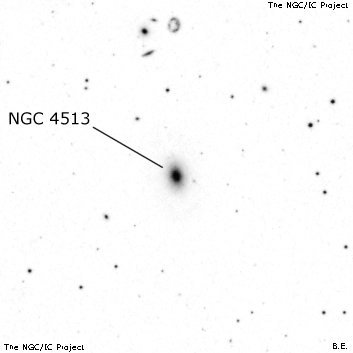NGC/IC Project Restoration Effort
(This is a very very beta version)
NGC4513


Basic Information
Location and Magnitude
Right Ascension: 12:32:1.6
Declination: +66:19:59
Constellation: DRA
Visual Magnitude: 13.0
Historic Information
Discoverer: d'Arrest
Year of discovery: 1866
Discovery aperture: 11.0
Observational
Summary description: F, R (? vS Cl)
Sub-type: S0
Corwin's Notes
=====
NGC 4513 has a remarkably thin, and very beautiful, faint blue outer ring. It
could well serve as a prototype of the lenticular RINGED galaxies. It shows
well on the DSS2B image.
Coincidentally, it is just south of the other type of RING galaxy, in this
case, VII Zw 466 = A1229+66. The origin of the rings is completely different.
In the case of NGC 4513, gravitational resonances internal to the galaxy
generate the ring, while VII Zw 466 is probably the result of a nearly direct
collision between two galaxies, at least one of which is a spiral.
Steve's Notes
=====
NGC 4513
24" (5/30/16): at 225x; fairly faint, fairly small, elongated 3:2 SSW-NNE, 0.6'x0.4', small bright core.
The triple system VII Zw 467 = CGCG 315-044 (2 members seen) is 4' NNE and VII Zw 466 = CGCG 315-043 (empty collisional RING galaxy) is 4' N. PGC 41549 appeared very faint to faint, very small, round, 12" diameter, visible continuously with averted vision. Both PGC 2686685 and VII Zw 466 were challenging objects, only occasionally visible.
48" (4/4/13): at 488x; VII Zw 466 appeared fairly faint, small, round with a slightly brighter rim and darker center. The ring was irregular lit and brighter on the west side with a couple of slightly brighter knots north and south.
PGC 3441759, the faintest member of triple system VII Zw 467, appeared very faint, extremely small, round, 6" diameter. PGC 41549, the brightest component, is fairly faint, small, round, high surface brightness and PGC 2686685 is faint, small, elongated 2:1 NW-SE, 20"x10".
17.5" (4/15/93): faint, small, elongated 3:2 SSW-NNE, very small bright core, stellar nucleus.



